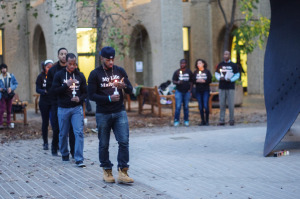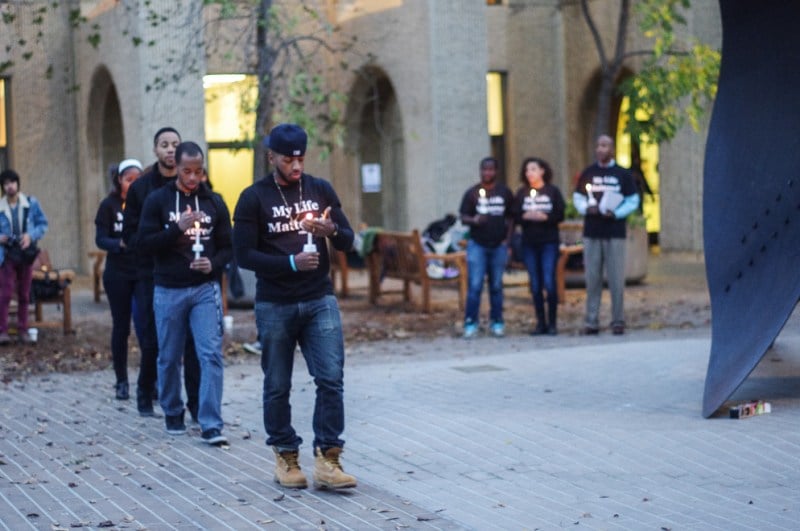On Monday night Stanford Law School students, professors, and administrators in commemorative tee shirts gathered in front of the Crown Quadrangle in order to honor black people killed by police officers.
Krista Whitaker, third year law student, and Darryl Long, first year law student, organized the event with the help of other members of Stanford’s Black Law Student Association (BLSA). Approximately one hundred people attended the event, the vast majority wearing black “My life mattered” shirts, each with the name of a person killed by police on the back.
Whitaker kicked off the event by presenting the overall message of the night.

“We are here simply to acknowledge that the lives lost to police brutality did matter, not to say that other lives don’t matter or matter less, but black lives matter too. Historically that hasn’t been the case,” Whitaker said.
Stanford Law Professor and Criminal Defense Clinic Director Ron Tyler spoke after Whitaker, touching first on the historical roots of slavery, and then addressing “the cast system that is America in 2015.”
While Tyler and others addressed the high profile cases of Michael Brown and Eric Garner, the vigil also focused on other instances of officer-involved shootings. As Whitaker emphasized, the point of the night was not to focus on circumstances surrounding a few individual cases, but rather to place a value on the many lives lost.
To illustrate this point, eight members of BLSA spoke at the event, reading narratives of police shooting victims from the perspective of the deceased represented on the protestors’ shirts. The first story shared was that of Timothy Stansbury, a recent high school graduate who was shot by police when going onto the rooftop of his apartment.
The second story shared was that of Michael Byoune, who protesters said was shot on Mother’s Day.
The third story was Kimani Gray, who protesters said was shot seven times by the police.
The fourth story was that of Miriam Carey, a woman protesters said was diagnosed with depression, multipolar disorder and schizophrenia and was killed when police fired 18 rounds into her car, with her one year old daughter in the backseat.
The fifth story was that of John Crawford, who protesters said was shot in a Walmart while holding a pellet gun being sold at the store in one hand and holding a phone in the other hand.
The story of Cameron Tillman, who according to protesters was a freshman in high school with a 3.7 GPA, was also shared.
Protesters said that Vonderrit Myers was carrying a sandwich when he was shot by police.
Finally, protesters shared the story of Akai Gurley, who protesters said was shot in the staircase of his girlfriend’s apartment building.
After the presentation of these stories, Professor Danielle Jones spoke of the emotional context events like these draw, but also the hope she sees.
“Even though I went into the [winter] break sort of dejected, once again seeing black lives stolen under egregious circumstances, those of us today represent the here and now. Take the time to look and see who is next to you. I see professors, deans, students. And we are ready for action. We are ready for change. And that’s a beautiful thing,” Jones said.
As Jones finished speaking, candles were lit and spread throughout the crowd.
“This is only a moment in time,” said Jones. “I blow this candle out one second and another second will replace it, but this is our moment.”
Some members of the demonstration also felt empowered. Annick Jordan, a first year law student and member of BLSA, read the narrative of Michael Byoune. She said she picked Byoune, who was killed in Los Angeles, because she was familiar with brutality associated with the LA Police Department.
“People signed up for their home towns or places they had connections to. Even though we didn’t know these people personally, it is more impactful.”
Cari Jeffries, first year law student, said that in many ways the tragic events that have come to the forefront in recent times has been energizing to law students. According to Jeffries, who wants to go into public service, “[we] get incredibly busy in law school and in the Stanford bubble and lose sight of why we wanted to go into law in the first place. This reminded us.”
While according to the organizers most of the attendees were associated with the Stanford Law School, at least some protestors were not Stanford students. Zachary Liberman, an undergraduate student at Berkeley visiting the Stanford campus, chose to attend the event after seeing fliers.
“A lot of times these groups are portrayed as radical, and I didn’t know what to expect,” said Liberman.
As a student at Berkeley, Liberman had seen the riots in Berkeley and Oakland and was “glad to see such a peaceful demonstration.”
Contact Ada Throckmorton at adastat ‘at’stanford.edu
